View in other NatureServe Network Field Guides
NatureServe
Montana
Utah
Wyoming
Idaho
Wisconsin
British Columbia
South Carolina
Yukon
California
New York
Arogos Skipper - Atrytone arogos
Other Names:
Iowa Skipper,
Atrytone arogos iowa
State Rank Reason (see State Rank above)
Arogos Skipper is dependent on native prairies and is believed to be declining in response to loss of habitat across its range among other threats. In Montana the species’ persistence is threatened for these reasons and more information is needed on its distribution, life history, and ecological relationships. As state rank cannot exceed global rank we have assigned the species a rank of S2S3, and will continue to refine the rank as more information becomes available.
General Description
[From Ferris and Brown 1981; Scott 1986; Opler and Wright 1999; Glassberg 2001] Forewing 1.3-1.4 cm. Uppersurface of males yellow-orange with broad gray-brown to black border, veins not darkened; females larger and darker, often with yellow-orange only on forewing disc and black streak in center. Undersurface of hindwing in both sexes yellow-orange with lighter veins, border with white fringe.
Phenology
One flight, July, in the north and Colorado; two flights, mid-May to early September in Missouri and Georgia; many flights, March to November, in Florida (Scott 1986). One brood areas, June and July; two brood areas, May to early July and August and September (Glassberg 2001). Mid-June to mid-July in the Rocky Mountain states (Ferris and Brown 1981), early July to early August in Colorado (Scott and Epstein 1987).
Diagnostic Characteristics
Best determined by a combination of smaller size, the uppersurface with a broad darkish border and a central yellow-orange area; undersurface of hindwing with yellow-orange with lighter veins, border with white fringe.
Species Range
Montana Range
Range Descriptions
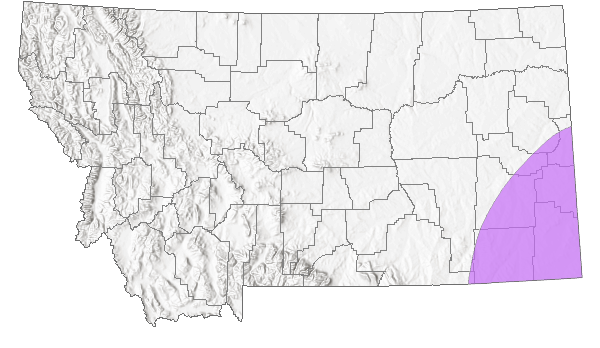
 Native
Native
Range Comments
Several separate prairie populations: 1) northeastern Wyoming, southeastern Montana, North Dakota, South Dakota and central Minnesota south to southern Texas, 2) Colorado Front Range, 3) New Jersey south to northeastern Georgia, 4) peninsular Florida, 5) Gulf Coast (Scott 1986; Opler and Wright 1999; Glassberg 2001); to 1890 m elevation in the Rocky Mountain states and Black Hills (Ferris and Brown 1981), to at least 1637 m elevation in Colorado (Brown 1957). Not reported in Montana through 1993 (Kohler 1980; Stanford and Opler 1993), one 1994 record in Carter County since then (FLMNH Lepidopterists' Society database; S. Kohler personal communication), at about 1000 m elevation. Localy rare to uncommon (Glassberg 2001).
Observations in Montana Natural Heritage Program Database
Number of Observations: 1
(Click on the following maps and charts to see full sized version)
Map Help and Descriptions
Relative Density
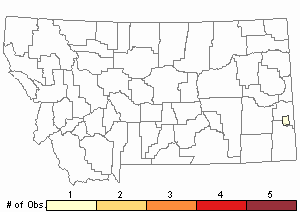
Recency

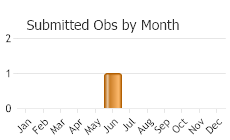
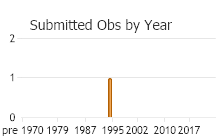
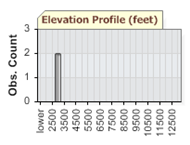 (Observations spanning multiple months or years are excluded from time charts)
(Observations spanning multiple months or years are excluded from time charts)
Migration
Non-migratory.
Habitat
Undisturbed tall and mixed-grass prairie, grassy meadows, serpentine barrens (Heitzman 1966; Ferris and Brown 1981; Scott 1986; Opler and Wright 1999; Glassberg 2001); most often dry prairie, less often wet prairie in the upper Midwest (Swengel and Swengel 1999). Habitat in Montana not described but probably similar.
Food Habits
Larval food plants are grasses, particularly Andropogon (multiple species), possibly Bouteloua and Panicum (Heitzman 1966; Scott 1986, 1992, 2006). Adults feed on flower nectar (including Apocynum, Asclepias, Carduus, Cirsium, Coreopsis, Dalea, Echinacea, Eriogonum, Eupatorium, Gallardia, Geranium, Grindelia, Helianthus, Heliopsis Heterotheca, Liatris, Lobelia, Medicago, Monarda, Penstemon, Petalostemum, Ratibida, Rudbeckia, Solidago, Verbena) and mud (Brown 1957; Heitzman 1966; Swengel and Swengel 1999; Scott 2014).
Reproductive Characteristics
Females lay eggs singly on undersurface of host plant leaves, typically 5-7 cm below leaf tip; a captive female laid 17 eggs (Heitzman 1966; Scott 1986, 1992, 2006). Eggs hatch in about 7 days, develop from L1 instar to L4 instar in about 32 days, enter diapause (overwinter) or continue to L6 instar in another 26 days and pupate; adults eclose (exit pupae) in about 12 days (Heitzman 1966). Larvae eat leaves, live in nests of rolled leaves (2-3) lined with silk, overwinter as L4 instar, pupate in leaf nest 10-20 cm above ground (Heitzman 1966; Scott 1979, 1986, 1992, 2006). Males perch in the afternoon low to the ground near host plant on slopes and flats waiting for passing females (Scott 1975b, 1986).
Stewardship Responsibility
References
- Literature Cited AboveLegend:
 View Online Publication
View Online Publication Brown, F.M. 1957. Colorado Butterflies. Proceedings; Numbers Three through Seven. Denver Museum of Natural History, Denver, Co.
Brown, F.M. 1957. Colorado Butterflies. Proceedings; Numbers Three through Seven. Denver Museum of Natural History, Denver, Co. Ferris, C.D. and F.M. Brown (eds). 1981. Butterflies of the Rocky Mountains. Univ. of Oklahoma Press. Norman. 442 pp.
Ferris, C.D. and F.M. Brown (eds). 1981. Butterflies of the Rocky Mountains. Univ. of Oklahoma Press. Norman. 442 pp. Glassberg, J. 2001. Butterflies through Binoculars: A Field Guide to the Butterflies of Western North America. Oxford University Press.
Glassberg, J. 2001. Butterflies through Binoculars: A Field Guide to the Butterflies of Western North America. Oxford University Press. Heitzman, J.R. 1966. The life history of Atrytone arogos (Hesperiidae). J. Lepidopterists' Soc. 20(3):177-181.
Heitzman, J.R. 1966. The life history of Atrytone arogos (Hesperiidae). J. Lepidopterists' Soc. 20(3):177-181. Kohler, S. 1980. Checklist of Montana Butterflies (Rhopalocera). Journal of the Lepidopterists' Society 34(1): 1-19.
Kohler, S. 1980. Checklist of Montana Butterflies (Rhopalocera). Journal of the Lepidopterists' Society 34(1): 1-19. Kohler, S. 2017. Personal communication regarding records of Atrytone arogos in Montana. 30 March 2017.
Kohler, S. 2017. Personal communication regarding records of Atrytone arogos in Montana. 30 March 2017. Opler, P.A. and A.B. Wright. 1999. A field guide to western butterflies. Second edition. Peterson Field Guides. Houghton Mifflin Company, Boston, Massachusetts. 540 pp.
Opler, P.A. and A.B. Wright. 1999. A field guide to western butterflies. Second edition. Peterson Field Guides. Houghton Mifflin Company, Boston, Massachusetts. 540 pp. Scott, J.A. 1975b. Mate-locating behavior of western North American butterflies. Journal of Research on the Lepidoptera 14:1-40.
Scott, J.A. 1975b. Mate-locating behavior of western North American butterflies. Journal of Research on the Lepidoptera 14:1-40. Scott, J.A. 1979. Hibernal diapause of North American Papilionoidea and Hesperioidea. Journal of Research on the Lepidoptera 18(3): 171-200.
Scott, J.A. 1979. Hibernal diapause of North American Papilionoidea and Hesperioidea. Journal of Research on the Lepidoptera 18(3): 171-200. Scott, J.A. 1986. The butterflies of North America: a natural history and field guide. Stanford University Press, Stanford, California.
Scott, J.A. 1986. The butterflies of North America: a natural history and field guide. Stanford University Press, Stanford, California. Scott, J.A. 1992. Hostplant records for butterflies and skippers (mostly from Colorado) 1959-1992, with new life histories and notes on oviposition, immatures, and ecology. Papilio new series #6. 185 p.
Scott, J.A. 1992. Hostplant records for butterflies and skippers (mostly from Colorado) 1959-1992, with new life histories and notes on oviposition, immatures, and ecology. Papilio new series #6. 185 p. Scott, J.A. 2006. Butterfly hostplant records, 1992-2005, with a treatise on the evolution of Erynnis, and a note on new terminology for mate-locating behavior. Papilio new series #14. 74 p.
Scott, J.A. 2006. Butterfly hostplant records, 1992-2005, with a treatise on the evolution of Erynnis, and a note on new terminology for mate-locating behavior. Papilio new series #14. 74 p. Scott, J.A. 2014. Lepidoptera of North America 13. Flower visitation by Colorado butterflies (40,615 records) with a review of the literature on pollination of Colorado plants and butterfly attraction (Lepidoptera: Hersperioidea and Papilionoidea). Contributions of the C.P. Gillette Museum of Arthopod Diversity. Fort Collins, CO: Colorado State University. 190 p.
Scott, J.A. 2014. Lepidoptera of North America 13. Flower visitation by Colorado butterflies (40,615 records) with a review of the literature on pollination of Colorado plants and butterfly attraction (Lepidoptera: Hersperioidea and Papilionoidea). Contributions of the C.P. Gillette Museum of Arthopod Diversity. Fort Collins, CO: Colorado State University. 190 p. Scott, J.A. and M.E. Epstein. 1987. Factors affecting phenology in a temperate insect community. American Midland Naturalist 117(1): 103-118.
Scott, J.A. and M.E. Epstein. 1987. Factors affecting phenology in a temperate insect community. American Midland Naturalist 117(1): 103-118. Stanford, R.E. 1981. Hesperiodea. In: Ferris, C.D. and F.M. Brown. Butterflies of the Rocky Mountain States. University of Oklahoma Press, Norman. pp. 67-140.
Stanford, R.E. 1981. Hesperiodea. In: Ferris, C.D. and F.M. Brown. Butterflies of the Rocky Mountain States. University of Oklahoma Press, Norman. pp. 67-140. Stanford, R.E. and P.A. Opler. 1993. Atlas of western USA butterflies: including adjacent parts of Canada and Mexico. Unpubl. Report. Denver and Fort Collins, Colorado 275 pp.
Stanford, R.E. and P.A. Opler. 1993. Atlas of western USA butterflies: including adjacent parts of Canada and Mexico. Unpubl. Report. Denver and Fort Collins, Colorado 275 pp. Swengel, A.B. and S.R. Swengel. 1999. Observations of prairie skippers (Oarisma poweshiek, Hesperia dakotae, H. leonardus pawnee, and Atrytone arogos iowa)(Lepidoptera:Hesperiidae) in Iowa, Minnesota, and North Dakota during 1988-1997. Great Lakes Entomologist 32:267-292.
Swengel, A.B. and S.R. Swengel. 1999. Observations of prairie skippers (Oarisma poweshiek, Hesperia dakotae, H. leonardus pawnee, and Atrytone arogos iowa)(Lepidoptera:Hesperiidae) in Iowa, Minnesota, and North Dakota during 1988-1997. Great Lakes Entomologist 32:267-292.
- Additional ReferencesLegend:
 View Online Publication
View Online Publication
Do you know of a citation we're missing? Allen, T.J., J.P. Brock, and J. Glassberg. 2005. Caterpillars in the field and garden: a field guide to the butterfly caterpillars of North America. Oxford University Press.
Allen, T.J., J.P. Brock, and J. Glassberg. 2005. Caterpillars in the field and garden: a field guide to the butterfly caterpillars of North America. Oxford University Press. Brock, J.P. and K. Kaufman. 2003. Kaufman Field Guide to Butterflies of North America. Houghton Mifflin Company, New York, NY 284 pp.
Brock, J.P. and K. Kaufman. 2003. Kaufman Field Guide to Butterflies of North America. Houghton Mifflin Company, New York, NY 284 pp. Forister, M.L., C.A. Halsch, C.C. Nice, J.A. Fordyce, T.E. Dilts, J.C. Oliver, K.L. Prudic, A.M. Shapiro, J.K. Wilson, J. Glassberg. 2021. Fewer butterflies seen by community scientists across the warming and drying landscapes of the American West. Science 371:1042-1045.
Forister, M.L., C.A. Halsch, C.C. Nice, J.A. Fordyce, T.E. Dilts, J.C. Oliver, K.L. Prudic, A.M. Shapiro, J.K. Wilson, J. Glassberg. 2021. Fewer butterflies seen by community scientists across the warming and drying landscapes of the American West. Science 371:1042-1045. Forister, M.L., E.M. Grames, C.A. Halsch, K.J. Burls, C.F. Carroll, K.L. Bell, J.P. Jahner, et al. 2023. Assessing risk for butterflies in the context of climate change, demographic uncertainty, and heterogeneous data sources. Ecological Monographs 93(3):e1584. https://doi.org/10.1002/ecm.1584
Forister, M.L., E.M. Grames, C.A. Halsch, K.J. Burls, C.F. Carroll, K.L. Bell, J.P. Jahner, et al. 2023. Assessing risk for butterflies in the context of climate change, demographic uncertainty, and heterogeneous data sources. Ecological Monographs 93(3):e1584. https://doi.org/10.1002/ecm.1584
- Web Search Engines for Articles on "Arogos Skipper"
- Additional Sources of Information Related to "Insects"





